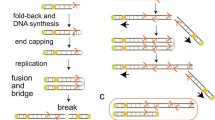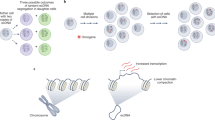Abstract
In 25–30% of cases of breast cancer tumors, the amplification of the chromosome fragment around ERBB2 underlies the increased expression of genes adjacent to ERBB2. The increased expression of genes within ERBB2-containing amplicons may impact not only the growth and development of the tumor, but also the sensitivity of the tumor to different types of anti-cancer therapies. The initial cause of the amplification and the exact borders of ERBB2-amplified chromosome fragment are still not completely characterized. No specific DNA sequences were found on the junction regions during intrachromosomal DNA amplification. We hypothesized that amplification borders can be specified by the structural peculiarities of DNA, rather than the particular DNA sequence. This study focused on the mapping of ERBB2 amplification borders in breast cancer and the search for unusual structural features of DNA at the borders of the identified amplicons. The copy number of ten genes adjacent to ERBB2 was evaluated by real time PCR in 162 breast cancer samples. Several ERBB2-containing amplicons of various lengths were revealed. In the majority of the analyzed samples, the borders of these amplicons were located within ZNFN1A3 and RARA genes. A bioinformatics analysis of the nucleotide sequence peculiarities around ERBB2 gene revealed the presence of AT-rich DNA regions with a high degree of flexibility. These regions were able to form stable secondary structures. Positions of these sites strongly coincide with the positions of the ERBB2-containing amplicon borders found in real time PCR experiments. Based on the obtained results, one can suppose that the structural features of DNA are involved in the formation of ERBB2-containing amplicon borders in breast cancer cells and the data are of importance for understanding the mechanisms of oncogene amplification.
Similar content being viewed by others
Abbreviations
- aCGH:
-
array-chromosomal genomic hybridization
- ERBB2 :
-
cellular homolog of type-2 bird erythroblastoma virus oncogene v-erbB
- FISH:
-
fluorescent in situ hybridization
- IHC:
-
immunohistochemistry
- BC:
-
breast cancer
References
Jacobson K.K., Morrison L.E., Henderson B.T., Blondin B.A., Wilber K.A., Legator M.S., O’Hare A., Van Stedum S.C., Proffitt J.H., Seelig S.A., Coon J.S. 2004. Gene copy mapping of the ERBB2/TOP2A region in breast cancer. Genes Chromos. Cancer. 40, 19–31.
Polanovski O.L., Lebedenko E.N., Deyev S.M. 2012. ERBB oncogene proteins as targets for monoclonal antibodies. Biochemistry (Moscow). 77, 227–245.
McClintock B. 1951. Chromosome organization and genic expression. Cold Spring Harbor Symp. Quant. Biol. 6, 13–47.
Singer M.J., Mesner L.D., Friedman C.L., Trask B.J., Hamlin J.L. 2000. Amplification of the human dihydrofolate reductase gene via double minutes is initiated by chromosome breaks. Proc. Natl. Acad. Sci. U. S. A. 97, 7921–7926.
Kuwahara Y. 2004. Alternative mechanisms of gene amplification in human cancers. Genes Chromosomes Cancer. 41, 125–132.
Kopnin B.P. 2007. Genome instability and oncogenesis. Mol. Biol. (Moscow). 41, 329–339.
Zlotorynski E., Rahat A., Skaug J., Ben-Porat N., Ozeri E., Hershberg R. 2003. Molecular basis for expression of common and rare fragile sites. Mol. Cell. Biol. 2, 7143–7151.
Glover T., Stein C. 1987. Induction of sister chromatid exchanges at common fragile sites. Am. J. Hum. Genet. 41, 882–890.
Glover T., Stein C. 1988. Chromosome breakage and recombination at fragile sites. Am. J. Hum. Genet. 43, 265–273.
Wang N., Testa J., Smith D. 1993. Determination of the specificity of aphidicolin-induced breakage of the human 3p14.2 fragile site. Genomics. 17, 341–347.
Rassool F., McKeithan T., Neilly M., van Melle E., Espinosa III R., Le Beau M. 1991. Preferential integration of marker DNA into the chromosomal fragile site at 3p14: An approach to cloning fragile sites. Proc. Natl. Acad. Sci. U. S. A. 88, 6657–6661.
Hellman A., Zlotorynski E., Scherer S.W., Cheung J., Vincent J.B., Smith D.I. 2002. A role for common fragile site induction in amplification of human oncogenes. Cancer Cell. 1, 89–97.
Miller C. 2006. Genomic amplification of MET with boundaries within fragile site FRA7G and upregulation of MET pathways in esophageal adenocarcinoma. Oncogene. 25, 409–418.
Coquelle A. 1997. Expression of fragile sites triggers intrachromosomal mammalian gene amplification and sets boundaries to early amplicons. Cell. 89, 215–225.
Fry M., Loeb L.A. 1994. The fragile X syndrome d(CGG)n nucleotide repeats form a stable tetrahelical structure. Proc. Natl. Acad. Sci. U. S. A. 91, 4950–4954.
Gacy A.M., Goellner G., Juranic N., Macura S., McMurray C.T. 1995. Trinucleotide repeats that expand in human disease form hairpin structures in vitro. Cell. 81, 533–540.
Pearson C.E., Eichler E.E., Lorenzetti D., Kramer S.F., Zoghbi H.Y. 1998. Interruptions in the triplet repeats of SCA1 and FRAXA reduce the propensity and complexity of slipped strand DNA (S-DNA) formation. Biochemistry. 37, 2701–2708.
Cao W., Hashibe M., Rao J. 2003. Comparison of methods for DNA extraction from paraffin-embedded tissues and buccal cells. Cancer Detect. Prev. 27, 397–404.
Pfaffl M.W. 2001. A new mathematical model for relative quantification in real-time RT-PCR. Nucleic Acids Res. 29, 2002–2007.
Persson K., Pandis N., Mertens F., Borg A., Baldetorp B., Killander D. 1999. Chromosomal aberrations in breast cancer: A comparison between cytogenetics and comparative genomic hybridization. Genes Chromos. Cancer. 25, 115–122.
Okonechnikov K., Golosova O., Fursov M. 2012. Unipro UGENE: A unified bioinformatics toolkit. Bioinformatics. 28, 1166–1167.
Zuker M. 2003. Mfold web server for nucleic acid folding and hybridization prediction. Nucleic Acids Res. 31, 3406–3415.
Edgren H., Murumagi A., Kangaspeska S., Nicorici D., Hongisto V., Kleivi K., Rye I.H., Nyberg S., Wolf M., Borresen-Dale A.L., Kallioniemi O. 2011. Identification of fusion genes in breast cancer by paired-end RNA-sequencing. Genome Biol. 12, 345–358.
Hyman E., Kauraniemi P., Hautaniemi S., Wolf M., Mousses S., Rozenblum E. 2002. Impact of DNA amplification on gene expression patterns in breast cancer. Cancer Res. 62, 6240–6245.
Arriola E., Marchio C., Tan D.S., Drury S.C., Lambros M.B., Natrajan R., Rodriguez-Pinilla S.M., Mackay A., Tamber N., Fenwick K., Jones C., Dowsett M., Ashworth A., Reis-Filho J.S. 2008. Genomic analysis of the HER2/TOP2A amplicon in breast cancer and breast cancer cell lines. J. Tech. Meth. Pathol. 88, 491–503.
Sircoulomb F., Bekhouche I., Finetti P., Adelaide J., Ben Hamida A., Bonansea J., Raynaud S., Innocenti C., Charafe-Jauffret E., Tarpin C., Ben Ayed F., Viens P., Jacquemier J., Bertucci F., Birnbaum D., Chaffanet M. 2010. Genome profiling of ERBB2-amplified breast cancers. BMC Cancer. 10, 539–557.
Mishmar D., Rahat A., Scherer S.W., Nyakatura G., Hinzmann B. Molecular characterization of a common fragile site (FRA7H) on human chromosome 7 by the cloning of a simian virus 40 integration site. 1998. Proc. Natl. Acad. Sci. U. S. A. 95, 8141–8146.
Marottab M., Chen X., Inoshita A., Stephens R., Thomas Budd G., Crowe J.P., Lyons J., Kondratova A., Tubbs R., Tanaka H. 2012. A common copy-number breakpoint of ERBB2 amplification in breast cancer colocalizes with a complex block of segmental duplications. Breast Cancer Res. 14, R150.
Author information
Authors and Affiliations
Corresponding author
Additional information
Original Russian Text © N.Yu. Matsenko, S.P. Kovalenko, 2013, published in Molekulyarnaya Biologiya, 2013, Vol. 47, No. 5, pp. 818–827.
Rights and permissions
About this article
Cite this article
Matsenko, N.Y., Kovalenko, S.P. DNA structural features on borders of ERBB2 amplicons in breast cancer. Mol Biol 47, 712–720 (2013). https://doi.org/10.1134/S0026893313050142
Received:
Accepted:
Published:
Issue Date:
DOI: https://doi.org/10.1134/S0026893313050142




